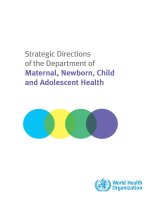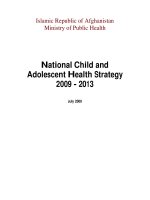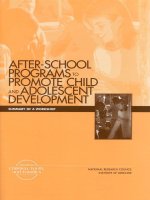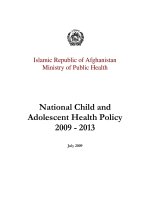child and adolescent counseling chapter 16
Bạn đang xem bản rút gọn của tài liệu. Xem và tải ngay bản đầy đủ của tài liệu tại đây (111.87 KB, 27 trang )
Chapter 16
Consultation and
Collaboration
You must be the change you wish to see in
the world.
Mahatma Gandhi
© 2011 Brooks/Cole, A
Chapter Objectives
After reading this chapter, you should be able to:
•Define consultation and collaboration
•Discuss models of consultation
•Talk about roles of consultants
•Explain collaboration
•Outline ways to build teams
•Describe assessment types and instruments
© 2011 Brooks/Cole, A
Consultation
• A process in which the counselor
works with (parent, teacher,
administrator) with the goal of positive
change in the child
• Voluntary problem-solving process
with goals of enhanced services and
improved functioning
© 2011 Brooks/Cole, A
Consultation with Children
Typical tasks involve the following:
• professional development workshops
• assisting teachers
• providing resources
• interpreting information
• consult with other specialists
© 2011 Brooks/Cole, A
Mental Health Consultation
• Focus on primary prevention and
helping professionals as well as others
• Interaction between 2 professionals
• Consultant an expert, diagnoses a
problem and provides a solution
© 2011 Brooks/Cole, A
Mental Health Consultation
• Client-centered case consultation
• Consultee-centered case consultation
• Program-centered administrative
consultation
• Consultee-centered administrative
consultation
© 2011 Brooks/Cole, A
Process Consultation
• A skill, interest in how things happen
rather than what is done
• Set of activities to help the consultee
perceive, understand, and act upon
events within one’s environment
• focus on how problems are solved and
the system in which they occur
© 2011 Brooks/Cole, A
Process Consultation
Consultant and consultee examine six areas:
• Communication patterns
• Group member roles
• Group problem solving and decision making
• Group norms and growth
• Leadership and authority
• Intergroup cooperation and competition
© 2011 Brooks/Cole, A
Behavioral Consultation
• More structured model; application of
systems theory and principles of learning
to a problem-solving process:
• Problem identification and analysis
• Selection of target behavior
• Behavioral objectives
• Plan, design, implementation
• Evaluate of behavioral change program
© 2011 Brooks/Cole, A
Cross-Cultural Consultation
Ingraham (2000) suggests
• Support consultee success
• Value multiple perspectives
• Create emotional safety and support
© 2011 Brooks/Cole, A
Cross-Cultural Consultation
Brown, Pryzwansky and Schulte provide
questions to assess
•
Hierarchy
•
Who should be involved
•
What leads to use
•
Allowing the right not to participate
© 2011 Brooks/Cole, A
The Consulting Process
1. Pre-entry
•
look at oneself to see if you are right for
the task and services to be provided
2. Entry, problem exploration and contracting
• learn about needs, presenting problem,
people involved, previous interventions,
and expectations of seeker
© 2011 Brooks/Cole, A
The Consulting Process (Cont.)
3. Diagnosis stage
• Information gathering, problem
confirmation, goal setting, and potential
interventions
4. Solution searching and intervention
selection
• avoid favorite paradigm
• consider human and structural factors
© 2011 Brooks/Cole, A
The Consulting Process (Cont.)
5. Evaluation
• Ensures professional effectiveness
• Were goals achieved?
• Did interventions work?
© 2011 Brooks/Cole, A
The Consulting Process (Cont.)
6. Termination
• Describe what was and was not
successful
• Look for areas of improvement
© 2011 Brooks/Cole, A
Myrick’s approach
1.
2.
3.
4.
5.
6.
Identify the problem clearly.
Clarify the situation.
Determine the desired outcome.
Gather any needed information.
Develop a plan of action.
Evaluate and revise as needed.
© 2011 Brooks/Cole, A
Consultation Interventions
• Role Shift
o changing
one’s behavior to elicit
behavior change in another person
• Logical Consequences
o experience
natural consequence rather
than punishment
o teach
rules of society
© 2011 Brooks/Cole, A
Consultation Interventions
• Listing of Behaviors
• Isolation Techniques
o unacceptable
behavior results in
removal from group
o quiet
o if
place, but not out of sight
worse, time out room
© 2011 Brooks/Cole, A
Collaboration
Friend and Cook (2000) definition:
• A style for direct interaction between 2
co-equal parties voluntarily engaged in
shared decisions making process as
they work towards a common goal.
© 2011 Brooks/Cole, A
Collaboration
Five stages of problem solving for
collaborative consultation:
1. Coming together
2. Defining a shared vision
3. Developing a plan
4. Taking action
5. Evaluating progress
© 2011 Brooks/Cole, A
Guidelines on whether to use
collaboration
or
consultation
•
Determine how the two services are viewed by
the consumer
• Counselor should reflect on their personal
reactions to the two services and comfort with
each
• Collaboration may be method if parameters of
consultation impossible
• Fundamental to choice is nature of problem,
the context in which it occurs and the skills of
everyone involved.
© 2011 Brooks/Cole, A
Reasons for Collaboration
Collaborative efforts may involve nurturing
relationships to:
• increase resources
• enhance effectiveness
• decrease fragmentation
• cost efficiency
© 2011 Brooks/Cole, A
Teaming
• Specialized work purpose
• Have shared goals and are
interdependent
• Each team member is aware of the
focus, the responsibilities and the pal
for accomplishing the task
© 2011 Brooks/Cole, A
Assessment as an
Intervention
• Counselors often use a variety of tools
to help understand children
• Some of the more commonly used
assessment tools are interviews, case
histories and behavioral observations
© 2011 Brooks/Cole, A
Mental Status Exam
Observations include:
1. General appearance, behavior, attitude
2. Speech characteristics and thought
process
3. Emotional status and reactions
4. Content of thought
© 2011 Brooks/Cole, A









